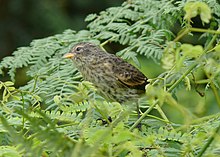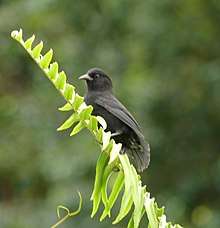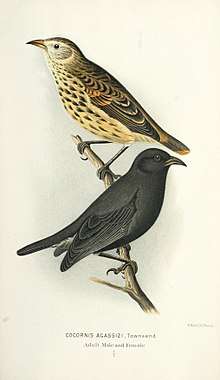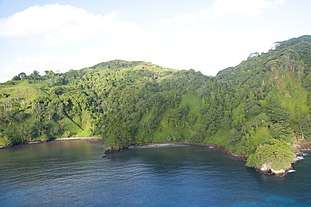Cocos finch
The Cocos finch or Cocos Island finch (Pinaroloxias inornata) is the only one of the Darwin's finches not native to the Galápagos Islands, and the only member of the genus Pinaroloxias. Sometimes classified in the family Emberizidae, more recent studies have shown it to belongs in the tanager family, Thraupidae. It is endemic to Cocos Island, which is approximately 360 miles (580 km) south of Costa Rica.[2][3][4]
| Cocos finch | |
|---|---|
 | |
| Cocos Finch, female | |
 | |
| Cocos Finch, male | |
| Scientific classification | |
| Kingdom: | Animalia |
| Phylum: | Chordata |
| Class: | Aves |
| Order: | Passeriformes |
| Family: | Thraupidae |
| Genus: | Pinaroloxias Sharpe, 1885 |
| Species: | P. inornata |
| Binomial name | |
| Pinaroloxias inornata (Gould, 1843) | |

It is a chunky 12 cm long finch, weighing around 12.5 g and with a black decurved pointed bill. The male is entirely black, while the female is a heavily streaked brown, with a paler underside. The young are similar but have yellow bills. The standard clutch is two brown-spotted white eggs, which are hatched in a roughly spherical nest built at the end of a tree branch.[5][6][7]
Taxonomy
The species name of the Cocos finch, Inornata , meaning plain or unadorned in Latin,[8] was coined by Augustus Addison Gould in 1843. The genus of the Cocos finch would later be verified by Richard Bowlder Sharpe in 1885.[2] The Cocos finch was originally placed in the family Emperizidae but recent phylogenic studies shows that diversification of the Cocos finch originates in the family Thraupidae.[9][10][11] The Cocos finch was first categorized to be closer to the warbler finch clade due to the similar morphology of cousin warbler finches.[3][4] Although, there has been evidence claiming that the Cocos finch belongs closer to the tree finches due to its phylogenic studies via mtDNA sequence matching closely to related birds of the tree finch clade.[8]
The Cocos finch shares many morphological similarities to other Darwin's finches despite having been separated from the Galapagos Islands.[12] What is unique, however, of the Cocos finch, is that they display an inter-species variation in feeding habits. The variation in foraging behaviors are hypothesized to be possible by observational learning from other Cocos finches.[12][13] These feeding specializations are independent of any morphological changes, sex and age differences, rather, they are derived from an inter-species variation found within the Cocos finch. Still, despite its variation in feeding patterns, Cocos finches are categorized as one species with no known subspecies.[13]
Description
The Cocos finch stands at about 12 cm long weighing in at about 12.5 g. The bird has a small pointed beak for eating berries and insects that are its main diet.[12][5][6] They are sexually dimorphic in that the males have black feathers from the tail, breast, nape, and crown. Unlike male finches found in Galapagos island, male Cocos finches have black beaks year-round.[5][14][6]
Female Cocos finch have a lighter brown complexion compared to a male Cocos finch. There is a black splattering of feathers on their breast area down to the flank and rump. The belly of the female Cocos finch is milky white compared to the mantle of the bird. The nape and crown area are more noticeably black.[5][2][6]
The call of a Cocos finch can be described as a "buzzy" like sound with a high-pitched ending note. The beginning of the call can form a “djirr” sound followed by a high pitched “tiew” sound. Calls can also include a high pitched “phzzzz” sound.[6][5]
Distribution and Habitat

The Cocos finch is exclusively found in Cocos Island (1,997 km2 area), 580 km SE from Costa Rica.[5][15] Cocos finches are not known to have traveled outside of Cocos Island making its habitat and reproduction range to only be at 30 km2 within the island.[5] The habitat of the Cocos finch is mostly within Hibiscus thickets, closed-canopy forest and woodland forest.[5][6]
The climate within Cocos Island is described to be a typical rain forest climate with high humidity and chances for rainfall. The island has a varied landscape with bodies of lakes, streams, and caves and is home to other species including endemic lizards (only 2 species), small mice, small cats, and some migratory birds.[15]
Ecology and Behavior
Foraging Patterns
Cocos finches known to be a generalist species, although they are also known to specialize in an individual level which can result in different foraging behaviors within individual Cocos finches.[12] This specialized behavior of Cocos finches can be explained through learning foraging patterns through other Cocos finches and can resonate said individual behavior to other Cocos Finches.[12][13]
Breeding
Cocos finch usually nest throughout the year; however, their breeding season falls usually at around January–February.[15][7] They form a nest using lichen and dry moss as their main material. Eggs are in clutch sizes of about 4–5 with a distinctive pink/light brown spots.[6][14]
Threats
Cocos finches face mammalian predatory encounters including native and introduced rats and cats in the island. Despite its predators, there is no evidence of high predatory pressures on the Cocos finches themselves. Scientists conclude that due to the low predatory pressures on Cocos finches, they have developed this specialized feeding behavior to evolve to a more generalist species.[13][5]
Status
Cocos Island is a natural reserved island and that there is limited human interaction towards the Cocos finch and to other Cocos Island inhabitants. While there has been increasing tourism around the island, there is no evidence of high disturbance rates from these tourists to affect the wildlife in the island including the Cocos Finch.[5][16]
While the predation and disturbance rate of Cocos finch are low along with a steady population rate, the IUCN deems the Cocos finch to be vulnerable due to the small habitat it occupies; about 30 km2 of the whole Cocos Island.[17][16]
As of now, there are about 6,000-15,000 Cocos Finches living isolated in Cocos Island.[1][16][17]
References
- BirdLife International (2016). "Pinaroloxias inornata". The IUCN Red List of Threatened Species. e.T22723792A94833441. doi:10.2305/iucn.uk.2016-3.rlts.t22723792a94833441.en.
- "Cocos Island Finch Pinaroloxias inornata (Gould, 1843)". Avibase - The World Bird Database. Retrieved 2019-12-04.
- Grant, Peter; Grant, B. Rosemary (2002). "Adaptive Radiation of Darwin's Finches". American Scientist. 90 (2): 130. Bibcode:2002AmSci..90..130G. doi:10.1511/2002.2.130. ISSN 0003-0996.
- Schluter, Dolph (September 1984). "Morphological and Phylogenetic Relations Among the Darwin's Finches". Evolution. 38 (5): 921–930. doi:10.2307/2408428. JSTOR 2408428.
- "Cocos Finch Pinaroloxias inornata". Data Zone. Bird Life International. Retrieved 2019-12-05.
- Grant, Peter R. (March 2002). "Birds, Mammals, & Reptiles of the Galápagos Islands: An Identification Guide. By Andy Swash and, Rob Still; with illustrations by Ian Lewington. New Haven (Connecticut): Yale University Press. $24.95. 168 p; ill.; index of English and scientific names. 2000". The Quarterly Review of Biology. 77 (1): 79–79. doi:10.1086/343641. ISBN 0-300-08864-7. ISSN 0033-5770.
- Raffaele, Herbert A. (September 1990). "A Guide to the Birds of Costa Rica.F. Gary Stiles , Alexander F. Skutch". The Quarterly Review of Biology. 65 (3): 365–366. doi:10.1086/416883. ISSN 0033-5770.
- "Latin Definition for: inornatus, inornata, inornatum (ID: 23980) - Latin Dictionary and Grammar Resources - Latdict". latin-dictionary.net. Retrieved 2019-12-04.
- Sato, A.; O'hUigin, C.; Figueroa, F.; Grant, P. R.; Grant, B. R.; Tichy, H.; Klein, J. (1999-04-27). "Phylogeny of Darwin's finches as revealed by mtDNA sequences". Proceedings of the National Academy of Sciences. 96 (9): 5101–5106. Bibcode:1999PNAS...96.5101S. doi:10.1073/pnas.96.9.5101. ISSN 0027-8424. PMID 10220425.
- "Cocos Finch". thewebsiteofeverything.com. Retrieved 2019-12-04.
- Walther, Christian (October 2002). "Crustal structure of the Cocos Ridge northeast of Cocos Island, Panamá Basin". Geophysical Research Letters. 29 (20): 47–1–47-4. Bibcode:2002GeoRL..29.1986W. doi:10.1029/2001gl014267. ISSN 0094-8276.
- Werner, T. K.; Sherry, T. W. (1987-08-01). "Behavioral feeding specialization in Pinaroloxias inornata, the "Darwin's Finch" of Cocos Island, Costa Rica". Proceedings of the National Academy of Sciences. 84 (15): 5506–5510. Bibcode:1987PNAS...84.5506W. doi:10.1073/pnas.84.15.5506. ISSN 0027-8424.
- Smith, James N. M.; Sweatman, Hugh P. A. (1976). "Feeding Habits and Morphological Variation in Cocos Finches". The Condor. 78 (2): 244. doi:10.2307/1366860. JSTOR 1366860.
- Hudon, Jocelyn (January 1987). "Guide des passereaux granivores. Embérizinés Gilbert C. Armani". The Auk. 104 (1): 152–153. doi:10.2307/4087255. ISSN 0004-8038. JSTOR 4087255.
- "Cocos Island National Park, Costa Rica", Dictionary of Geotourism, Springer Singapore, 2019-11-11, pp. 91–92, doi:10.1007/978-981-13-2538-0_368, ISBN 978-981-13-2537-3
- Butchart, Stuart H. M; Stattersfield, Alison J; Bennun, Leon A; Shutes, Sue M; Akçakaya, H. Resit; Baillie, Jonathan E. M; Stuart, Simon N; Hilton-Taylor, Craig; Mace, Georgina M (2004-10-26). Walt V. Reid (ed.). "Measuring Global Trends in the Status of Biodiversity: Red List Indices for Birds". PLoS Biology. 2 (12): e383. doi:10.1371/journal.pbio.0020383. ISSN 1545-7885. PMC 524254. PMID 15510230.
- "Birds to watch 2: the world list of threatened birds: the official source for birds on the IUCN red list". Choice Reviews Online. 34 (2): 34–0930c-34–0930c. 1996-10-01. doi:10.5860/choice.34-0930c. ISSN 0009-4978.
Stiles, F. G.; Skutch, A. F. (October 1989). A guide to the birds of Costa Rica. Ithaca, NY: Cornell University Press. ISBN 0-8014-9600-4.
